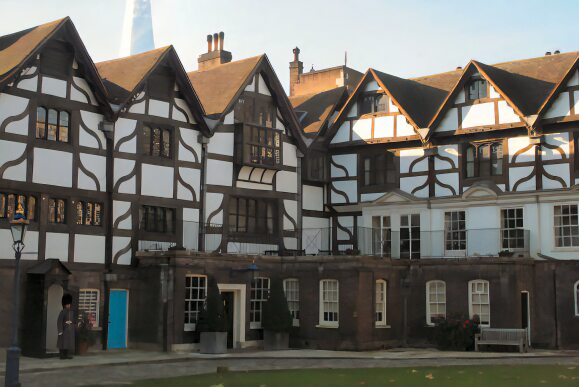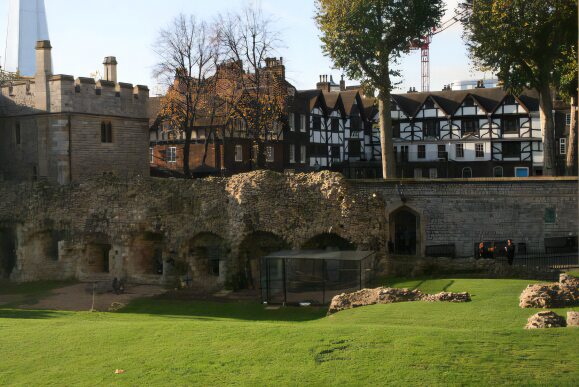Tower of London
The half-timbered Queen's House, which faces Tower Green, was built in around 1530, in the reign of King Henry VIII, in a very different style than the rest of the Tower of London.
Henry VIII probably built the Queen's House for his second Queen, Anne Boleyn, who was executed soon afterwards. Anne is said to have stayed there prior to her execution on nearby Tower Green, ironically imprisoned in the same lodgings that she stayed in before her coronation in 1533. Queen Anne was interred at the Chapel of St. Peter ad Vincula (St. Peter in Chains) within the Tower complex, where a Victorian pavement in the chapel, now commemorates her life. Anne's lodgings had become uninhabitable by the end of the sixteenth century and were demolished by the end of the eighteenth century. The present Queen's House is not where Anne was imprisoned as these apartments were not built until around 1540, at least 4 years after Anne Boleyn's execution.
Queens House, Tower of London
Anne's daughter, Queen Elizabeth I, probably dined at Queen's House in later years. Early on, a floor for a Council Chamber was added to the Queen's House and it was there, in 1608, that Guy Fawkes was forced to confess his plot to blow up James I and the Houses of Parliament with gunpowder. Guy Fawkes was almost certainly tortured at the Tower of London. Along with the other conspirators in the Gunpowder Plot, he was executed by being hanged, drawn and quartered.
Tower of London
In 1610 Arbella Stuart, the first cousin of James I and granddaughter of the formidable Bess of Hardwick, secretly married William Seymour, grandson of Lady Catherine Grey, who himself had a claim to the throne, without seeking the King's permission. James, disliking this 'combination of titles' placed Arbella under house arrest at Lambeth, and sent Seymour to the Tower. The couple plotted their escape but unfortunately missed their rendevous at Lee in Kent. Arbella set sail alone but was captured and sent to the Tower where she was lodged in the Queen's House. William was more fortunate and arrived safely in France. When Arbella fell ill in the tower in 1614, it was suspected she was faking illness to escape or evoke sympathy. However, she refused both food and medical attention and was said by some to be delusional towards the end, believing William was coming to rescue her. She never saw her husband again and died in the Tower on 25 September 1615 from illnesses exacerbated by her refusal to eat. Arbella Stuart's ghost is reputed to haunt the Queen's House.
The Queen's House is one of the few such buildings to survive the Great Fire of London of 1666 and was spared because of its protected spot inside the Tower's stone walls.
The Queen's House is currently the home of the Resident Governor of the Tower of London. Originally, the Lieutenant of the Tower lived here and was the custodian of several famous prisoners, including Lady Jane Grey, and the last prisoner held in the Tower, Rudolf Hess in 1941.
The Byward Tower PreviousNext The Bowyer Tower
